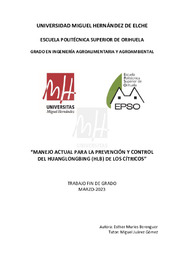Por favor, use este identificador para citar o enlazar este ítem:
https://hdl.handle.net/11000/29145Registro completo de metadatos
| Campo DC | Valor | Lengua/Idioma |
|---|---|---|
| dc.contributor.advisor | Juárez Gómez, Miguel | - |
| dc.contributor.author | Muries Berenguer, Esther | - |
| dc.contributor.other | Departamentos de la UMH::Producción Vegetal y Microbiología | es_ES |
| dc.date.accessioned | 2023-04-18T09:56:10Z | - |
| dc.date.available | 2023-04-18T09:56:10Z | - |
| dc.date.created | 2023-03 | - |
| dc.identifier.uri | https://hdl.handle.net/11000/29145 | - |
| dc.description.abstract | El Huanglongbing, también conocido como “enverdecimiento de los cítricos”, es una de las enfermedades más devastadoras de los cítricos, y ha causado la devastación de numerosas áreas de cultivo en todo el mundo durante las últimas décadas. Esta enfermedad, limitada al floema, está asociada a tres microorganismos denominados “Candidatus Liberibacter asiaticus”, “Candidatus Liberibacter americanus” y “Candidatus Liberibacter africanus”, los cuales, son diseminados por los psílidos vectores “Trioza erytreae” y “Diaphorina citri”. Hasta el momento, no existe una cura establecida para el HLB, por lo que los esfuerzos se han centrado en la prevención de su entrada a nuevas áreas. Para combatir esta enfermedad, se hace necesaria la introducción de estrategias multidisciplinares. En el presente trabajo, se expondrá una exhaustiva revisión de la información científica de la que se dispone actualmente sobre los antecedentes del HLB, y sobre los métodos existentes para su prevención, así como los desafíos a los que se enfrenta la comunidad científica y los productores de cítricos ante el control de esta enfermedad. | es_ES |
| dc.description.abstract | Huanglongbing, also known as “citrus greening”, is one of the most devastating diseases of citrus, having caused the devastation of many growing areas around the world during the last decades. This disease, limited to the phloem, is associated with three microorganisms called "Candidatus Liberibacter asiaticus", "Candidatus Liberibacter americanus" and "Candidatus Liberibacter africanus", which are spread by the psyllid vectors "Trioza erytreae" and "Diaphorina citri". Up to now, it does not exist an established cure for HLB, so efforts have focused on preventing its entry into new areas. To combat this disease, it is necessary to introduce multidisciplinary strategies. In the present work, an exhaustive review of the scientific information that is currently available on the background of HLB, and about the existing methods for its prevention will be exposed, as well as the challenges faced by the scientific community and citrus producers in the control of this disease. | es_ES |
| dc.format | application/pdf | es_ES |
| dc.format.extent | 53 | es_ES |
| dc.language.iso | spa | es_ES |
| dc.publisher | Universidad Miguel Hernández de Elche | es_ES |
| dc.rights | info:eu-repo/semantics/openAccess | es_ES |
| dc.rights.uri | http://creativecommons.org/licenses/by-nc-nd/4.0/ | * |
| dc.subject | Huanglongbing | es_ES |
| dc.subject | Candidatus Liberbacter spp | es_ES |
| dc.subject | Trioza erytreae | es_ES |
| dc.subject | Diaphorina citri | es_ES |
| dc.subject.other | CDU::6 - Ciencias aplicadas::63 - Agricultura. Silvicultura. Zootecnia. Caza. Pesca | es_ES |
| dc.title | Manejo actual para la prevención y control del Huanglongbind (HLB) de los cítricos | es_ES |
| dc.type | info:eu-repo/semantics/bachelorThesis | es_ES |

Ver/Abrir:
TFG Muries Berenguer, Esther.pdf
1,86 MB
Adobe PDF
Compartir:
 La licencia se describe como: Atribución-NonComercial-NoDerivada 4.0 Internacional.
La licencia se describe como: Atribución-NonComercial-NoDerivada 4.0 Internacional.
.png)